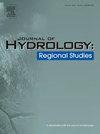Modeling framework for coordinated operation of series-parallel reservoir groups considering storage-discharge regulation mechanisms
IF 4.7
2区 地球科学
Q1 WATER RESOURCES
引用次数: 0
Abstract
Study region
The core reservoir group of the main stream from the lower Jinsha River to the middle Yangtze River in China includes Wudongde, Baihetan, Xiluodu, Xiangjiaba cascade reservoirs (abbreviated as Jinxia Reservoir Group), and the Three Gorges Reservoir.
Study focus
A coordinated operational modeling framework that simultaneously performs multi-objective optimization and storage-discharge regulation, as well as a multi-level watershed generalization method for extracting operation objects, relationships, and periods, have been proposed.
New hydrological insights for the region
When encountering floods with design frequency P ≥ 1 %, the Jinxia Reservoir Group should prioritize synchronous regulation order, providing 37.27 × 108 m3 storage capacity (24.06 % of the total flood control storage capacity) to the Three Gorges Reservoir for coordinated flood control pressure management in the middle and lower Yangtze River. Furthermore, several notable findings were obtained: (a) The response intensity of reservoirs to regulation mechanisms is positively correlated with storage capacity. (b) Differences in the regulation order can lead to differences of 1.3–2.6 times storage capacity consumption. The findings of this study contribute to the advancement of operational modeling theory and the development of refined coordinated operation schemes for reservoir groups.
求助全文
约1分钟内获得全文
求助全文
来源期刊

Journal of Hydrology-Regional Studies
Earth and Planetary Sciences-Earth and Planetary Sciences (miscellaneous)
CiteScore
6.70
自引率
8.50%
发文量
284
审稿时长
60 days
期刊介绍:
Journal of Hydrology: Regional Studies publishes original research papers enhancing the science of hydrology and aiming at region-specific problems, past and future conditions, analysis, review and solutions. The journal particularly welcomes research papers that deliver new insights into region-specific hydrological processes and responses to changing conditions, as well as contributions that incorporate interdisciplinarity and translational science.
 求助内容:
求助内容: 应助结果提醒方式:
应助结果提醒方式:


